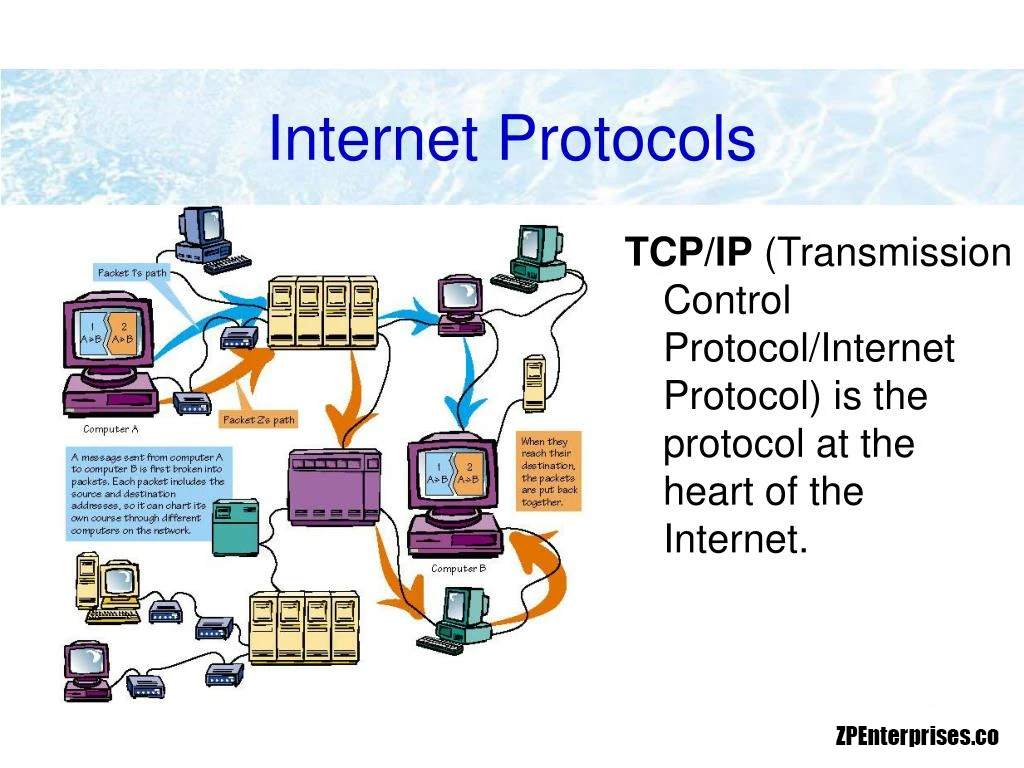The Internet Protocol (IP) is a set of requirements for addressing and routing data on the Internet. IP can be used with several transport protocols, including TCP and UDP.
The Internet Protocol (IP) is a protocol, or set of rules, for routing and addressing packets of data so that they can travel across networks and arrive at the correct destination. Data traversing the Internet is divided into smaller pieces called packets. IP information is attached to each packet, which helps routers send packets to the right place. Every device or domain that connects to the Internet is assigned an IP address, and as packets are directed to the IP address attached to them, data arrives where needed.
Once the packets arrive at their destination, they are handled differently depending on which transport protocol is used in combination with IP. The most common transport protocols are TCP and UDP.
What is a network protocol?
In networking, a protocol is a standardized way of doing specific actions and formatting data so that two or more devices can communicate and understand each other.
To understand why protocols are necessary, consider the process of mailing a letter. On the envelope, addresses are written in the following order: name, street address, city, state, and zip code. If an envelope is dropped into a mailbox with the zip code written first, followed by the street address, followed by the state, and so on, the post office won’t deliver it. There is an agreed-upon protocol for writing addresses for the postal system to work. In the same way, all IP data packets must present certain information in a particular order, and all IP addresses follow a standardized format.
What is an IP address? How does IP addressing work?
An IP address is a unique identifier assigned to a device or domain that connects to the Internet. Each IP address is a series of characters, such as ‘192.168.1.1’. Via DNS resolvers, which translate human-readable domain names into IP addresses, users can access websites without memorizing this complex series of characters. Each IP packet will contain both the IP address of the device or domain sending the packet and the IP address of the intended recipient, much like how both the destination address and the return address are included on a piece of mail.
IPv4 vs. IPv6
The fourth version of IP (IPv4 for short) was introduced in 1983. However, just as only so many possible permutations for automobile license plate numbers must be reformatted periodically, the supply of available IPv4 addresses has depleted. IPv6 addresses have many more characters and thus more permutations; however, IPv6 is not yet wholly adopted, and most domains and devices still have IPv4 addresses. For more on IPv4 and IPv6, see What is my IP address?
What is an IP packet?
IP packets are created by adding an IP header to each packet of data before it is sent on its way. An IP header is just a series of bits (ones and zeros), and it records several pieces of information about the packet, including the sending and receiving IP address. IP headers also report:
- Header length
- Packet length
- Time to live (TTL), or the number of network hops a packet can make before it is discarded.
- Which transport protocol is being used (TCP, UDP, etc.)
In total, there are 14 fields for information in IPv4 headers, although one of them is optional.
How does IP routing work?
The Internet comprises interconnected large networks responsible for specific blocks of IP addresses; these large networks are known as autonomous systems (AS). Various routing protocols, including BGP, help route packets across ASes based on their destination IP addresses. Routers have routing tables that indicate which ASes the packets should travel through to reach the desired destination as quickly as possible. Packets travel from AS to AS until they reach one that claims responsibility for the targeted IP address. That AS then internally routes the packets to the destination.
Protocols attach packet headers at different layers of the OSI model:
Packets can take different routes to the same place, just as a group driving to an agreed-upon destination can take different roads.
What is TCP/IP?
The Transmission Control Protocol (TCP) is a transport protocol that dictates how data is sent and received. A TCP header is included in the data portion of each packet that uses TCP/IP. Before transmitting data, TCP opens a connection with the recipient. TCP ensures that all packets arrive in order once transmission begins. Via TCP, the recipient will acknowledge receiving each packet that arrives. Missing packets will be sent again if the receipt is not acknowledged.
TCP is designed for reliability, not speed. Because TCP has to ensure all packets arrive in order, loading data via TCP/IP can take longer if some packets are missing.
TCP and IP were initially designed to be used together, often called the TCP/IP suite. However, other transport protocols can be used with IP.
What is UDP/IP?
The User Datagram Protocol, or UDP, is another widely used transport protocol. It is faster than TCP, but it is also less reliable. UDP does not ensure all packets are delivered and in order and does not establish a connection before beginning or receiving transmissions.
Do network switches refer to IP addresses?
A network switch is an appliance that forwards data packets within a local area network (LAN). Most network switches operate at layer 2, the data link layer, not layer 3, the network layer, and therefore use MAC addresses to forward packets, not IP addresses. To learn more, see What is a network switch?





